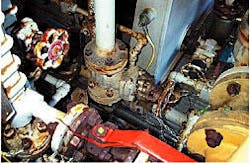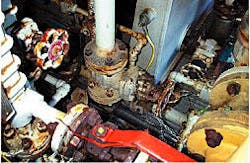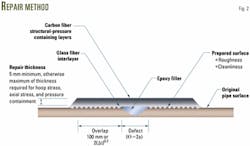Composite materials, primarily carbon fiber and epoxy resin, that are lightweight, yet offer a high-degree of strength and durability provided a way to repair corroded piping on two North Sea platforms without having to shut in production.
BP PLC during routine nondestructive testing on its Lomond and North Everest platforms found the closed-drain systems to have internal corrosion along 2-in. carbon steel pipes. Girth weld locations were the most affected areas, 15 sites in total, although two flange connectors and an isolation valve (Fig. 1) also displayed signs of corrosion.
The repair of this corroded piping was made by a method used by FD Alliance (FDA), a co-operative venture between the engineering group Devonport Management Ltd. (DML), owner and operator of Devonport Royal Dockyard Ltd., Plymouth, UK. and the engineering company Furmanite International Ltd., Kendal, UK.
The closed-drain system runs at a design temperature of between -6 and 20° C., and therefore is well within the 100° C. recommended design maximum for standard composite repairs, according to FDA.
Repair system
FDA says its repair system is based on composite materials, primarily carbon fiber and epoxy resin, that offer up to 10 times the strength of steel, with twice its stiffness, and only one-quarter of the density.
It says that because scheduled shutdown of the platforms was not due for another 3 months, when all defective lines would be changed out, BP required a method to repair the closed-drain system without stopping production.
The work needed would restore the system's pressure containment ability and structural strength, while keeping all lines live.
A factor influencing the effectiveness of composite repairs is the quality of the surface preparation. A high-quality bond allows composite repairs to be classified as permanent, according to FDA.
In the case of the girth welds on the 2-in. closed drain lines, FDA specified a surface preparation to be carried out by the platform staff prior to the repair team's arrival. The design pressure on this system was 6 barg (87 psig), which called for a 100-mm (4-in.) overlap of the composite beyond each edge of the defect area (Fig. 2). Thus each defect area required a 200-mm pipe section to be prepared for bonding.
FDA says one advantage of its composite repairs is that they are low profile and conform closely to the pipe surface.
The material's properties mean that only a thin layer need be applied to significantly strengthen the substrate, a particular benefit where the repair is in an area with restricted access.
In the case of the girth weld repairs on Lomond and Everest, the repair design thickness was 5.0 mm.
FDA designed the composite repair to restore both pressure containment (hoop strengthening) and structural strength (axial and bending loads) to the closed drain line.
It achieved this by using very high bond strengths between the composite and the pipe substrate and by including a multi-axial, quasi-isotropic carbon.
Repair of the two identical flange connections on North Everest and Lomond was slightly more complicated because of the geometry and confined access, according to FDA. To effectively encapsulate the flanges with carbon fiber and ensure pressure containment, it had to create a smooth profile for the carbon reinforcement to be laid over the flange.
FDA indicates that the ability of composites to repair flanges in situ adds versatility and allows the method to fit any geometry, no matter how complicated the angles.
Thus flanges, nozzles, and all manner of joints (such as T-joints, Y-joints, and K-joints) can all be repaired by the method.
FDA said that isolation valves on North Everest also suffered from corrosion and wrapping these valves had not been a common practice. Previously, valves had to be replaced, and replacement, obviously, requires a full shutdown.
The technicians appointed to assess the Everest work, however, felt that composites could be used, albeit with a slightly increased thickness of 10 mm to give greater stiffness to the repair laminate.
The repair required an overlap of 100 mm on either side of the defect to ensure full structural strength and to provide pressure containment.
Layering process
FDA's method, in all cases, uses a layered process.
The first layer applied to the pipe is a tie-coat of glass fiber fabric, hand impregnated with epoxy resin. This layer provides the interface to the steel and insulates the carbon fiber from the pipe substrate.
Next applied is the glass layer. After it cures, the layer is visually inspected to ensure a high quality bond to the substrate.
The last layers are the carbon-fiber strengthening layers over the tie-coat. These layers restore full pressure containment and structural strength to the pipe.
Prior to curing, the layers have a sacrificial peel ply applied to aid consolidation, remove any excess resin from the composite, and to provide a textured finish suitable for the application of any required coatings.
Despite its temporary nature in this particular application, FDA says the repairs are now classified as permanent repairs.
They can be designed for up to 25 year service that can extend asset use beyond its intended life.
The repairs on each platform took about 3-4 working days, without any disruption to production, according to FDA.




